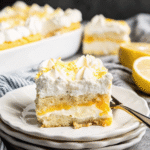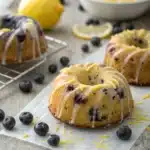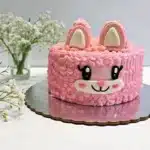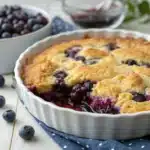Vanilla Cake Recipe is my go-to when I want to serve something easy, elegant, and unforgettable. It’s rooted in tradition but designed for today’s busy kitchens. Moist, fluffy, and full of real vanilla flavor, this recipe is just the kind of dessert you’ll want to share with loved ones—whether you’re celebrating a birthday, a quiet night in, or just the end of a long day.
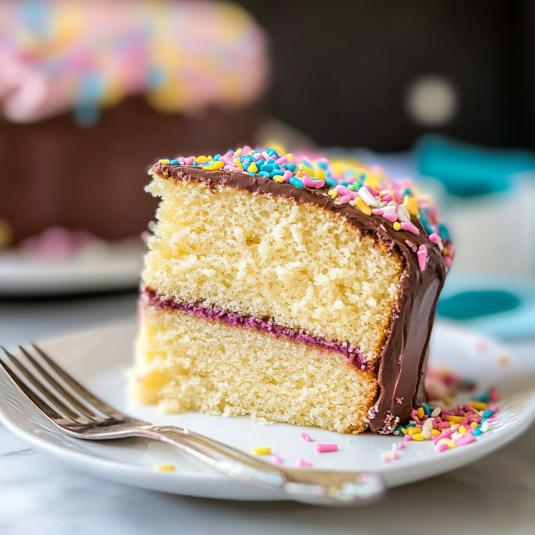
Table of Contents
Why Everyone Needs a Go-To Vanilla Cake Recipe
A Timeless Cake for Every Baker
Every home baker needs a go-to vanilla cake recipe in their arsenal. It’s more than just a dessert—it’s a foundation for countless celebrations and creative twists. Whether you’re baking from scratch for the first time or you’re a seasoned pro, a reliable vanilla cake is a game-changer in your kitchen.
This classic cake is celebrated for its soft, fluffy texture and perfectly sweet, aromatic flavor. When made with high-quality ingredients and a little technique, the results are simply unbeatable. It’s the kind of dessert that pleases everyone—simple, elegant, and always in style.
You can dress it up with sprinkles for a birthday or keep it refined with smooth buttercream for a wedding. That’s why this vanilla cake recipe works for every occasion. It’s not just about taste—it’s about versatility and reliability.
Print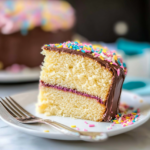
The Best Vanilla Cake Recipe Made From Scratch (Moist & Easy)
Description
This is my perfectly soft, plush, and classic vanilla cake recipe, made completely from scratch! So simple to make and tastes much better than box-mix!
Ingredients
½ cup (113 g) unsalted butter softened to room temperature
½ cup (120 ml) avocado, canola or vegetable oil
1 ½ cup (300 g) granulated sugar
4 large eggs room temperature preferred
1 Tablespoon vanilla extract
3 cups (375 g) all-purpose flour
1 Tablespoon baking powder
½ teaspoon salt
1 ¼ cup (300 ml) buttermilk room temperature preferred
1 batch Chocolate Frosting click link for recipe, or use one of the other frostings recommended in the notes below
Instructions
1- Preheat oven to 350F (177C) and prepare two deep 8″ round cake pans by lining the bottoms with parchment paper and lightly greasing the sides. Set aside.
2- In the bowl of a stand mixer (or in a large bowl using an electric mixer) cream together the butter, canola oil and sugar until creamy and well-combined.
½ cup (113 g) unsalted butter,½ cup (120 ml) avocado, canola or vegetable oil,1 ½ cup (300 g) granulated sugar
3- Add eggs, one at a time, beating until thoroughly combined after each addition.
4 large eggs
4- Stir in vanilla extract.
1 Tablespoon vanilla extract
5- In a separate, medium-sized bowl, whisk together flour, baking powder, and salt.
3 cups (375 g) all-purpose flour,1 Tablespoon baking powder,½ teaspoon salt
6- Using a spatula and gently hand-mixing, alternate adding flour mixture and buttermilk to the butter mixture, starting and ending with flour mixture and mixing until just combined after each addition. The batter should be thoroughly combined, but there may be some small lumps in the batter and avoid over-mixing (and do not use your electric mixer or stand mixer for this step).
1 ¼ cup (300 ml) buttermilk
7- Evenly divide batter into your prepared cake pans, and bake on 350F (175C) for 30-35 minutes. When the cake is done, the surface should spring back to the touch and a toothpick inserted in the center should come out mostly clean with few moist crumbs (no wet batter).
8- Allow cakes to cool in their cake pans for 10-15 minutes before inverting onto cooling rack to cool completely before frosting.
9- Frost cake using my chocolate frosting (or see notes for other favorite frosting options) and decorate with sprinkles (if desired).
1 batch Chocolate Frosting
Notes
Cooking oil
You may use any neutral cooking oil instead of vegetable or canola oil. I generally don’t recommend olive oil, which is heavier and has a distinct flavor that could affect the end taste result of your cake.
Cake Flour
You may substitute cake flour for all-purpose flour. Use 3 ⅓ cups or 375g of cake flour.
Different size baking pans
13×9″ pan: This recipe makes enough for one 13×9″ baking pan. Readers have reported the approximate bake time is 30 minutes.
Two 9″ pans: Readers have reported this cake takes approximately 25 minutes to bake in 9″ pans.
Bundt pan: Readers have reported this cake takes approximately 40-45 minutes to bake in a bundt pan
Bake times for all pans listed above have been provided by readers who have tested this recipe in different sized pans. Please always use the toothpick test to check for doneness and note that your precise bake time may vary depending on your particular baking pan and your oven. I have not tested this recipe in any other baking pans, other than cupcake tins (details for baking cupcakes listed below).
Vanilla Cupcakes:
This recipe will make approximately 24 vanilla cupcakes. Fill cupcake liners no more than ¾ of the way full. Bake on 350F for 17-18 minutes or until a toothpick inserted in the center comes out with a few moist crumbs or clean.
Frosting Options
The chocolate frosting I linked to in the ingredients is my favorite pairing with this cake, but here are some other great options:
Buttercream Frosting
Cream Cheese Frosting
Ermine Frosting
Swiss Meringue Buttercream
How Vanilla Cake Differs from White or Yellow Cakes
While they might look similar, white cake, yellow cake, and a true vanilla cake recipe all have distinct differences that impact texture, color, and flavor:
| Type | Eggs Used | Fat Source | Color | Flavor |
|---|---|---|---|---|
| Vanilla Cake | Whole eggs | Butter + Oil (or either) | Pale golden | Prominent vanilla flavor |
| White Cake | Egg whites only | Often just butter | Bright white | Subtle vanilla, lighter taste |
| Yellow Cake | Whole eggs | Mostly butter | Rich golden yellow | Strong buttery and vanilla flavor |
The secret to the perfect vanilla cake recipe lies in its balance. It’s lighter than yellow cake but richer than white cake. The result? A soft, golden layer cake that holds up to frosting, fillings, and even sculpting. And thanks to its mild profile, it enhances rather than competes with toppings—be it chocolate ganache, berry compote, or cream cheese frosting.
Ingredients That Make the Perfect Vanilla Cake
Why Use Both Butter and Oil for a Soft Texture
A well-crafted vanilla cake recipe depends heavily on the right combination of fats. You might be tempted to use just butter for flavor or just oil for moisture—but combining both is what gives this cake its signature texture: tender, moist, and rich without feeling heavy.
Butter contributes that classic, creamy flavor we all love in baked goods. But oil brings in moisture that lingers even days after baking. While a cake made entirely with butter might taste great fresh out of the oven, it tends to dry out faster. On the flip side, using only oil can yield a soft crumb but falls flat in flavor. That’s why the perfect vanilla cake starts with a smart blend of both.
Here’s a breakdown of what you’ll need:
| Ingredient | Role in Texture & Flavor |
|---|---|
| Unsalted Butter | Adds flavor and structure |
| Neutral Oil (e.g. vegetable or canola) | Locks in moisture |
Using this duo, you get a cake that’s flavorful, fluffy, and tender with every bite.
The Role of Buttermilk, Eggs, and Sugar in Your Vanilla Cake Recipe
Another must-have for a professional-level vanilla cake recipe is buttermilk. This ingredient not only adds a subtle tang that balances the sweetness, but it also activates the baking powder, leading to a higher, fluffier rise.
- This is the real deal—crafted entirely from scratch, no mixes, no shortcuts.
- Eggs: Whole eggs bring richness, binding, and stability. Use room-temperature eggs for better emulsification.
- Granulated Sugar: White sugar keeps the crumb light. Avoid brown sugar here—it adds unwanted weight and moisture.
Each element plays a key role in making your homemade vanilla cake better than any boxed mix.
And let’s not forget the star of the show: pure vanilla extract. Whether you use store-bought or homemade, high-quality vanilla is crucial. Cheap artificial extracts just won’t give your cake that deep, warm, and fragrant flavor that defines a true vanilla cake recipe.
Here’s a quick ingredient checklist:
| Ingredient | Quantity | Notes |
|---|---|---|
| Unsalted butter | ½ cup (113g) | Room temperature, for easy creaming |
| Neutral oil | ½ cup (120ml) | Canola, avocado, or vegetable oil |
| Granulated sugar | 1½ cups (300g) | White sugar only |
| Large eggs | 4 | Room temp for better mixing |
| Vanilla extract | 1 Tbsp | Use high-quality or homemade |
| All-purpose flour | 3 cups (375g) | Can sub with 3⅓ cups cake flour |
| Baking powder | 1 Tbsp | Ensure freshness—don’t skip! |
| Salt | ½ tsp | Table salt or fine sea salt |
| Buttermilk | 1¼ cups (300ml) | Full-fat only for best moisture |
Step-by-Step Instructions for Baking a Moist Vanilla Cake
How to Properly Cream Ingredients for the Fluffiest Results
When it comes to baking the perfect cake, your technique matters just as much as your ingredients. That’s especially true with a vanilla cake recipe, where precision and care turn basic pantry items into bakery-worthy results.
Begin by beating the butter, oil, and sugar until the mixture becomes light and airy—about 2–3 minutes on medium speed using a stand or hand mixer. The goal here is to beat air into the fat, creating volume and setting the stage for a light crumb.
After creaming, add the eggs one by one, mixing thorougFinish by stirring in the vanilla, ensuring the flavor is thoroughly incorporated.
| Step | Why It Matters |
|---|---|
| Cream butter, oil, sugar | Adds air and builds structure |
| Add eggs gradually | Ensures uniform texture and prevents curdling |
| Mix in vanilla extract | Distributes the key vanilla flavor throughout |
Mixing Tips: Avoiding Overmixing and Undermixing Mistakes
The most common mistake when following a vanilla cake recipe is mixing too much or too little. With the wet ingredients ready, slowly alternate adding the dry mix and buttermilk.
Here’s how to do it right:
- In a separate bowl, whisk together your flour, baking powder, and salt.
- Add ⅓ of the dry mix to the wet ingredients and stir gently with a spatula.
- Pour in half of the buttermilk and fold it in without overworking the batter.
- Repeat until everything is just combined—no more, no less.
Pro Tip: Never use an electric mixer once you begin combining wet and dry ingredients. A spatula is your best friend here.
The batter should be smooth with a few small lumps—that’s perfectly okay. Mixing too much can make the cake tough and dry, while too little leaves flour pockets and a patchy texture.
Pour the batter evenly into two greased pans, then bake on the center oven rack at 350°F (177°C) for 30 to 35 minutes. Use the toothpick test—if it comes out with just a few moist crumbs, your vanilla cake recipe has succeeded!
| Problem | Cause | Fix |
|---|---|---|
| Dense or dry cake | Overmixed or overbaked batter | Fold gently and monitor baking time |
| Gummy or sunken center | Underbaked or batter overmixed | Use oven thermometer; avoid overhandling |
| Uneven texture | Poor dry-to-wet ratio or undermixed | Alternate ingredients and fold carefully |
Best Frostings and Fillings for Vanilla Cake
Classic Options: Chocolate, Buttercream, or Cream Cheese

A good vanilla cake recipe is like a blank canvas—ready to be dressed up in a hundred delicious ways. While it’s beautiful on its own, what takes it over the top is the frosting or filling you choose. The best pairings bring out the subtle warmth of vanilla without overpowering it.
Let’s start with the classics:
Cream Cheese Frosting: A slightly tangy twist that works well if you want a more decadent, less sugary finish. It’s also great for layered or sheet cakes.
Chocolate Frosting: Rich and bold, chocolate offers a perfect contrast to vanilla’s soft flavor. It’s also one of the most requested combos for birthday cakes.
Vanilla Buttercream: Light, creamy, and sweet—but not too sweet—this is the go-to frosting for a traditional vanilla cake recipe.
Here’s a quick guide to help you pick the right match:
| Frosting Type | Flavor Profile | Best For |
|---|---|---|
| Chocolate Frosting | Rich, deep, slightly bitter | Birthdays, celebrations |
| Vanilla Buttercream | Sweet, creamy, traditional | Weddings, kids’ cakes, cupcakes |
| Cream Cheese Frosting | Tangy, dense, luxurious | Layered cakes, fruit-filled variations |
| Ermine Frosting | Light, buttery, smooth | Elegant and vintage-style cakes |
Whatever you choose, make sure it complements the tender crumb and vanilla aroma of your cake—not compete with it.
Creative Pairings and Fillings That Go Well With Vanilla Cake
Looking to elevate your vanilla cake recipe beyond the basics? Creative fillings and toppings can transform your cake into a show-stopper.
Here are some ideas:
- Berry Compote: Fresh strawberries, blueberries, or raspberries cooked down into a jammy filling give a fruity brightness to each bite.
- Lemon Curd: Zesty and vibrant, lemon curd is a surprising but delightful partner to vanilla.
- Raspberry Jam + Whipped Cream: Layer this combo between cake tiers for a light, refreshing taste.
- Chocolate Ganache: For a rich and silky finish, pour a glossy ganache over the top of your cake. It sets beautifully and looks elegant.
- Salted Caramel Drizzle: Add a homemade caramel layer between the cake or on top to give it a sweet and salty twist.
| Creative Filling | Effect on Flavor |
|---|---|
| Fresh fruit compote | Brightens and balances sweetness |
| Lemon or citrus curd | Adds a tangy contrast to vanilla |
| Chocolate ganache | Deepens richness; elegant finish |
| Salted caramel | Adds complexity and elevates presentation |
| Whipped cream + jam | Lightens texture and adds visual appeal |
By pairing the right fillings and frostings, you can turn a classic vanilla cake recipe into something extraordinary—customized for any mood, season, or celebration.
Common Baking Mistakes and How to Avoid Them
Why Your Cake May Turn Dry or Crumbly
Even when using a tried-and-true vanilla cake recipe, a few simple missteps can lead to a dry, dense, or crumbly cake. Fortunately, these issues are easy to fix once you know what to look out for.
The most common causes of a disappointing vanilla cake include:
- Scooping flour directly from the bag usually leads to using more than needed. This throws off the moisture ratio and leads to a dense crumb. Always spoon the flour into your measuring cup and level it off—or better yet, use a kitchen scale.
- Overmixing the batter: Once the flour is added, mix gently. Overmixing activates gluten, which can make your cake tough and chewy.
- Overbaking: Even a few extra minutes in the oven can strip away moisture. A great vanilla cake recipe should come out of the oven when a toothpick shows just a few moist crumbs.
- Unmolding too soon: Flipping the cake out of the pan while it’s still hot may cause it to crack or crumble. Always let it cool for at least 10–15 minutes in the pan first.
| Mistake | Effect on Cake | How to Fix It |
|---|---|---|
| Too much flour | Dry and dense | Use spoon-and-level or weigh your ingredients |
| Overmixing | Chewy or gummy texture | Fold gently with a spatula, not a mixer |
| Baking too long | Dry edges and center | Use a timer and test with a toothpick |
| Removing too early | Cake breaks or crumbles | Let cool partially in the pan before unmolding |
A successful vanilla cake recipe delivers a soft, fluffy, and moist texture every time. Avoiding these common issues helps you create cakes that not only taste great but look stunning too.
How Baking Time and Pan Choice Affect the Final Texture
If your cake always turns out too dry or underbaked in the middle, the problem may be your pan or baking time—not the recipe itself. Every reliable vanilla cake recipe is sensitive to pan size, material, and oven temperature.
For example:
- Using a pan that’s too shallow can cause the cake to dry out faster.
- Deeper pans might underbake in the center if the temperature isn’t properly monitored.
- Dark metal pans cook faster than glass or ceramic.
Here’s a quick reference guide for bake times by pan type:
| Pan Type | Bake Time | Notes |
|---|---|---|
| Two 8” round pans | 30–35 minutes | Even layers, perfect for stacking |
| Two 9” round pans | 25–28 minutes | Slightly thinner layers |
| 13×9” sheet pan | 30–32 minutes | Ideal for casual or party cakes |
| 24 cupcake tins | 17–18 minutes | Fill ¾ full for perfect domes |
| Bundt pan | 40–45 minutes | Use lower-middle oven rack for even baking |
Pro Tip: Always preheat your oven and use a thermometer to verify internal temp. Many ovens are off by 10–25 degrees!
Also, avoid opening the oven door repeatedly. Each time you do, the temperature drops, which may cause the cake to sink or bake unevenly—especially in more delicate versions of a vanilla cake recipe.
Vanilla Cake Recipe Variations You Should Try
Vanilla Cupcakes, Layered Cakes, and Sheet Cake Ideas
A classic vanilla cake recipe stands out for its incredible versatility. With just a few tweaks in pan size, bake time, or presentation, you can transform it into cupcakes, layer cakes, sheet cakes, or even elegant tiered showpieces.
Here are popular variations using the exact same batter:
- Vanilla Cupcakes: Makes roughly 24 standard cupcakes. Fill each liner about ¾ full and bake at 350°F for 17–18 minutes. They’re fluffy, moist, and the perfect base for decorating.
- Two or Three-Layer Cake: Want to stack your cake for a birthday or wedding? Use 8” or 9” round pans and bake evenly. A classic vanilla cake recipe like this one stacks beautifully without collapsing or cracking.
- 13×9″ Sheet Cake: This is the easiest option for casual serving. You’ll still get the soft texture and rich vanilla flavor, but without the fuss of layering or frosting sides.
- Mini Cakes: Cut rounds from a sheet cake and layer them individually for a cute, elevated dessert that looks professional with little effort.
| Cake Format | Serving Size | Ideal For |
|---|---|---|
| Cupcakes (24) | 1 per guest | Birthdays, kids’ parties, bake sales |
| Two-Layer Cake (8–9”) | 12–14 slices | Birthdays, showers, elegant occasions |
| 13×9 Sheet Cake | 15–20 squares | Office parties, casual events |
| Mini Cakes | Individual servings | Weddings, upscale events, plated desserts |
How to Turn Your Vanilla Cake into Marble or Pineapple Upside-Down Cake
Ready to get creative? A well-balanced vanilla cake recipe can easily be turned into other popular cake styles. No need to start from scratch—just modify the batter slightly for a new flavor and visual appeal.
- Marble Cake: Before baking, remove one-third of the vanilla batter and stir in 2–3 tablespoons of cocoa powder. Layer alternating scoops of vanilla and chocolate batter, then use a knife to create a swirl pattern. It’s a beautiful and delicious twist.
- Pineapple Upside-Down Cake: Pour melted butter and brown sugar into the bottom of your cake pan, then layer with pineapple rings and cherries. Pour your vanilla batter over the top and bake. Once inverted, it reveals a caramelized fruit topping with a perfectly soft crumb.
- Almond or Citrus Variations: Swap half the vanilla extract with almond or lemon extract for a fresh spin. You can also fold in orange zest or poppy seeds for texture and aroma.
- Strawberry Shortcake Layers: Bake the batter in thinner layers and fill with whipped cream and sliced strawberries. The cake absorbs the juices beautifully while staying structured.
| Variation | How to Modify the Vanilla Batter |
|---|---|
| Marble Cake | Add cocoa to ⅓ of batter and swirl before baking |
| Pineapple Upside-Down Cake | Layer pineapple + brown sugar at bottom of pan |
| Almond/Lemon Cake | Replace some vanilla extract with citrus or nut flavor |
| Strawberry Shortcake | Add fruit + whipped cream between thin cake layers |
Thanks to its structure, flavor, and flexibility, this vanilla cake recipe can be used as the base for nearly any dessert style—from whimsical cupcakes to elegant plated cakes. Once you’ve mastered it, the possibilities are endless.
Storage, Freshness, and Make-Ahead Tips
How Long Does Vanilla Cake Stay Fresh?
A well-made vanilla cake recipe doesn’t just shine on day one—it should hold up beautifully for a few days. With proper storage, your cake can stay moist, flavorful, and ready to serve without losing its quality.
Here’s what you can expect:
- Room Temperature: If unfrosted, your vanilla cake can stay fresh for 2–3 days in an airtight container. Frosted cakes (especially those with buttercream or ganache) are best eaten within 48 hours for optimal texture.
- Refrigerated: A frosted or layered vanilla cake will last 4–5 days in the refrigerator. Wrap the cake in plastic wrap or store it in a cake carrier to prevent it from drying out.
- Frozen: Yes, you can freeze it! This vanilla cake recipe freezes very well. Individually wrap each layer in plastic, then foil, and place in a freezer-safe bag for storage up to 2 months.
| Storage Method | Time Fresh | How to Store It |
|---|---|---|
| Room Temperature | 2–3 days | Airtight container, avoid sunlight and heat |
| Refrigerator | 4–5 days | Covered with wrap or in cake carrier |
| Freezer | Up to 2 months | Double-wrapped, sealed in freezer-safe bag |
Tip: Bring refrigerated or frozen cakes to room temp before serving for the best texture and flavor.
Freezing and Thawing Cake Layers the Right Way
If you’re planning ahead, freezing your cake layers is a smart way to simplify prep for events. Luckily, this vanilla cake recipe is designed to hold its structure and moisture, even after freezing.
Here’s how to do it right:
- Cool completely: Never wrap warm cake. Wait until the layers are fully cooled on a wire rack.
- Wrap each : layer snugly in plastic wrap, then add a layer of foil for extra protection.
- Label and freeze: Use a marker to write the date on each layer. Place them in a flat area in your freezer to avoid bending or cracking.
- Thaw slowly: When ready to use, place the wrapped cake in the fridge overnight, then unwrap and let it come to room temp before frosting.
Why Vanilla Cake Is So Loved
The Flavor Profile of a Well-Made Vanilla Cake
It’s no surprise that the vanilla cake recipe remains a top favorite among home bakers and pastry chefs alike. A properly made vanilla cake isn’t just sweet—it’s deeply flavorful, balanced, and comforting in a way that few other cakes can match.
A great vanilla cake recipe delivers a soft, pillowy texture with just the right amount of moisture. The flavor is rich without being heavy, thanks to real butter, a splash of oil, and full-fat buttermilk. What makes it shine, though, is the vanilla itself—pure, floral, and slightly creamy. It’s subtle but unmistakable.
Unlike more intense flavors like chocolate or red velvet, vanilla allows other components—frosting, fruit, ganache—to shine. But even on its own, this cake stands tall. When done right, it’s a dessert that feels both nostalgic and elegant at once.
| Key Flavor Elements | Contribution to Taste |
|---|---|
| Pure vanilla extract | Warm, fragrant, and slightly sweet |
| Butter + oil blend | Soft, rich crumb with lasting moisture |
| Buttermilk | Mild tang that balances the sweetness |
| Balanced sweetness | Enhances flavor without overpowering |
In the hands of the right baker, a basic vanilla cake recipe becomes anything but basic—it becomes a celebration of texture, aroma, and flavor harmony.
Occasions Where Vanilla Cake Shines
If you’re wondering why vanilla cake remains a go-to across cultures and age groups, here’s the answer: it fits everywhere. Whether it’s a quiet family dinner or a 200-guest wedding, a soft and moist vanilla cake recipe will always feel appropriate and appreciated.
Here’s why:
- Universal appeal: It’s beloved by children and adults alike. Even people who “don’t love sweets” tend to say yes to vanilla cake.
- Easy to customize: Dress it up with chocolate, caramel, fruit, or edible flowers. Keep it classic or go over-the-top.
- Pairs with any filling: Fruit preserves, chocolate ganache, lemon curd, or a light mousse—all go beautifully with vanilla.
- Looks elegant: With a golden crumb and smooth, pale surface, it’s the perfect blank slate for fancy decorations or rustic finishes.
When it comes to timeless desserts, few things beat a moist, soft, and flavorful vanilla cake recipe. From the quality of your ingredients to the way you mix your batter, every detail matters. But once you understand the method, it becomes a foolproof go-to for birthdays, weddings, family dinners, or casual weekends at home.
Conclusion
With the right balance of butter, oil, and buttermilk, and the unmistakable aroma of pure vanilla extract, this cake delivers flavor that’s anything but boring. You now know how to bake it perfectly, avoid common pitfalls, choose the best frostings and fillings, and even store or freeze it with confidence.
Whether you keep it classic or dress it up with fruit, ganache, or cream, the beauty of this homemade vanilla cake recipe lies in its flexibility and consistent results. It’s the foundation of every baker’s recipe box—and now, it’s yours too.
Fore more recipes follow me in Facebook, medium and Pinterest
FAQs
What goes well on vanilla cake?
A classic vanilla cake recipe pairs beautifully with a wide range of toppings and frostings. Its soft flavor profile makes it incredibly versatile. Some of the best options include:
Chocolate frosting – Rich and bold, it adds depth and contrast.
Buttercream – Smooth and sweet, it’s the traditional choice.
Whipped cream – Light and airy, perfect for fresh fruit toppings.
Fresh berries or compote – Adds brightness and color.
Salted caramel – Offers a sweet-savory balance for a gourmet twist.
Whether you’re keeping it simple or going all out, the right topping enhances the cake without overpowering its delicate vanilla base.
How long will a vanilla cake stay fresh?
When stored properly, a vanilla cake recipe can stay fresh and delicious for days:
At room temperature: 2–3 days, if covered or in a cake container.
In the refrigerator: Up to 5 days, especially if frosted with buttercream.
In the freezer: Cake layers can be frozen for up to 2 months when tightly wrapped.
Always allow your cake to come back to room temperature before serving—it brings out the best texture and flavor.
Why do people like vanilla cake?
People love vanilla cake for its simplicity, versatility, and classic flavor. A well-made vanilla cake recipe is lightly sweet, fragrant, and moist—making it the perfect canvas for endless customizations.
Reasons people adore vanilla cake:
It’s universally loved – Appeals to all ages and taste preferences.
Pairs with anything – From fruit to frosting, it complements without competing.
Elegant presentation – Pale golden layers look stunning with minimal decor.
Customizable – Easily transformed into marble, citrus, or berry-based cakes.
It’s no wonder vanilla cake continues to be one of the most requested flavors for birthdays, weddings, and everyday celebrations.

